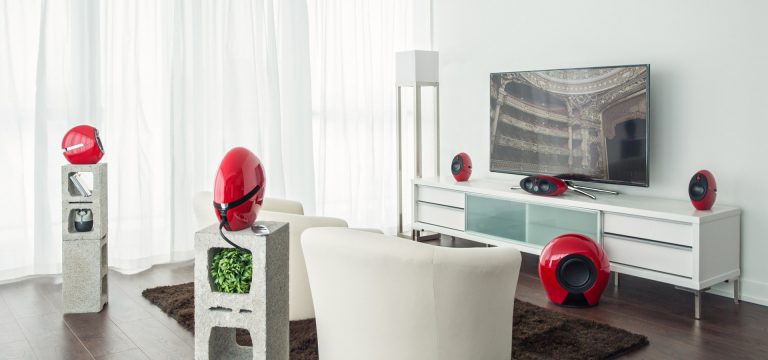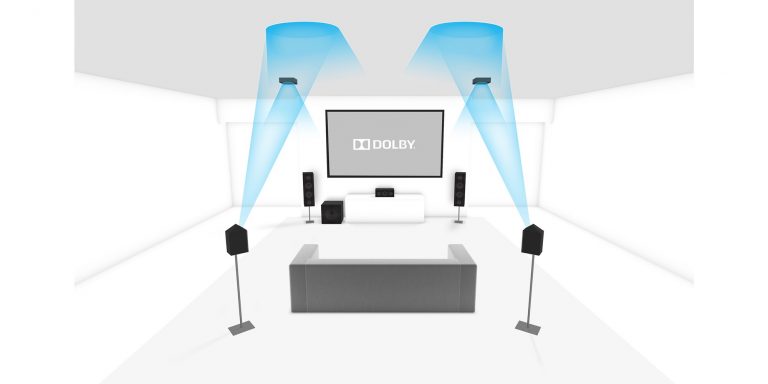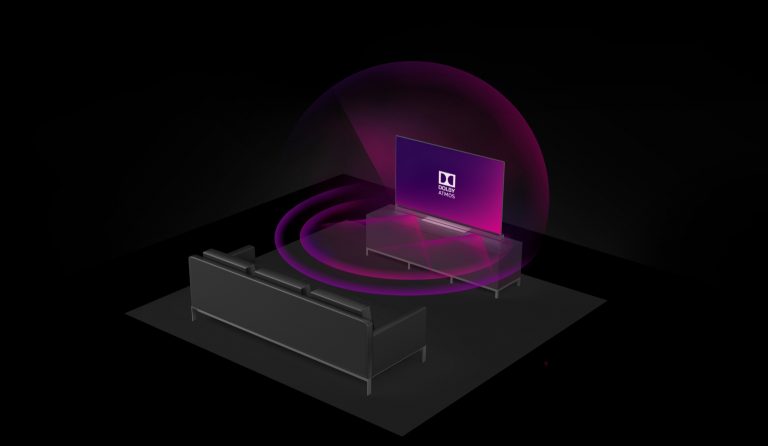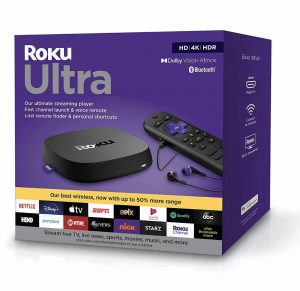Since the 1960s, Dolby Labs has been a pioneer in the audio and sound space, helping to power digital and surround sound for movies and music. Dolby Atmos is one of the company’s latest attempts to change how we experience our favorite films and kick back to our grooviest tunes. It allows sound to appear as though it is coming from all around us, even from above. We’ll explore how Dolby Atmos builds upon the surround sound of previous years and learn precisely how you can bring the tech into your home. Surround sound is a sound technique that we have enjoyed since the 1940s when Disney introduced it with its film, Fantasia. No longer were we limited to two speakers at the front of our theatres—we could now be immersed in sound with speakers all around us. There are quite a few ways to set up a surround sound system, with two of the most common for a home being either 5.1 or 7.1. The first number tells us how many speakers are in the setup, and the second number notes how many subwoofers there are for heart-pounding bass. A classic 5.1 setup will generally have three speakers in the front of the room for the left, right, and center channels. An additional two speakers are in the rear for the back-left and back-right channels, as well as a subwoofer which can be placed anywhere in the room (don’t forget that .1 in 5.1). A 7.1 setup would add two speakers placed to the immediate right and left of the seating area—these are known as surround left and right surround channels. These additional speakers can make the illusion of sound moving around you more convincing. With Dolby Surround Sound, you can hear the dinosaurs from Jurassic World run up from behind you or the evil spirit from your favorite horror film breathing on the back of your neck. Building upon surround sound, Dolby Atmos adds two new features to the mix—height and sound that can be interpreted as three-dimensional objects. These might sound a bit confusing, so let’s break them down. These additional speakers can be installed directly into a ceiling above your movie watching space or placed on the floor with the ability to bounce sound off the ceiling and down onto you. Imagine hearing the screaming sound of a jet as it appears to swoop above your head or the sound of a monster jumping above and rushing past you. These additional speaker channels are represented by a third number when describing surround sound setups. For example, a 5.1 setup with two Dolby Atmos speakers would now be identified as a 5.1.2 setup. With new height channels, Dolby Atmos creates a bubble of sound around you, which immerses you in your content.. Previously, sound engineers would need to specify precisely from which speakers sound would need to be played. Now, using three-dimensional objects, we can take a sound, such as a helicopter, and have Dolby Atmos determine from which speakers should play it. For example, different home theatre setups may have more or fewer speakers—remember before, when we discussed 5.1 vs. 7.1 surround sound setups? With three-dimensional objects, Dolby Atmos can give you the best experience with surround sound that adapts to your home theatre’s speaker system. Dolby Atmos makes movies and music sound all the more immersive thanks to its building upon surround sound technology with additional height channels and three-dimensional objects. Never before has sound seemed to surround you as it does with Dolby Atmos. Now that you know what Dolby Atmos is and what it does for your movie or music listening experience, let’s discuss what equipment you’ll need to hear it at home. Experienced home theater lovers can add new Dolby Atmos modules to their existing setups, as well as a compatible amplifier, to enjoy Dolby’s latest sound standard. These modules sit atop the front or rear surround speakers and fire up, bouncing sound off the ceiling and down towards your listening space. We recommend consulting your local home theater store if you are interested in going this route as it requires a slightly more detailed planning and setup process. Most individuals will likely start from scratch, so we’ve rounded up a few Dolby Atmos systems that we love. All of our selections use up-firing speakers to bounce sound off the ceiling rather than requiring the laborious installation of in-ceiling speakers. Remember, just because a service offers Dolby Atmos support does not mean that every film, show, or video has Dolby Atmos audio. To determine whether the content you are about to watch has Dolby Atmos audio, check the movie or show page before hitting the play button. If you’re looking for great content to enjoy, don’t forget to also check out our round-up of the top streaming services. Dolby Atmos doesn’t have to stay confined to your home; you can bring it with you on the move, whether to the upstairs bedroom or the local cafe. While the most authentic Atmos audio can only be experienced within your home theatre or a proper cinema with surround-sound speakers, you can enjoy Dolby Atmos to an extent with headphones and select smartphones. Headphones and smartphones with Dolby Atmos can’t surround you with speakers, so instead, they use an audio processing algorithm to create a virtual 360-degree soundscape. To listeners, this can help to establish a more immersive experience. With the proper hardware, you can enjoy Dolby Atmos within your own home. Many popular streaming services, including Netflix, HBO Max, and Disney+, offer movies and shows with Dolby Atmos for your enjoyment. All that’s left is for you to grab a bag of popcorn and dive into your favorite films.







